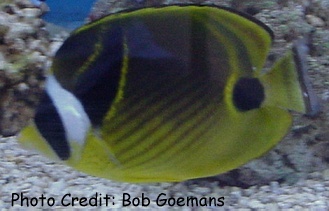
By Bob Goemans

Not Reef Tank Suitable
Likely Fish-Only Tank Suitable
Range: Indo-West Pacific Ocean: East Africa to Hawaiian Islands, north to Southern Japan and south to Lord Howe and Rapa Islands.
Size: 8 inches (20 cm)
Natural Environment: Inhabits lagoon patch reefs, reef flats, fringing reefs, back reefs, and boat channels at depths between 3 – 235 feet (1 – 70 m) and feeds on clams, worms, sea cucumbers, crustaceans, crabs, urchin feet, soft and stony coral polyps, hydroids, tunicates, nudibranchs, and minor amounts of algae. Usually found in pairs or small groups.
General Husbandry: One of the all-time favorites with hobbyists as its not only good looking, its among the hardist of all butterflyfish. Its body is basically yellow, with the upper half much darker than the lower half, and has ascending slanted reddish stripes that become hardly visible on the upper body. Its facial area has a broad black eye band, hence the common name ‘Raccoon’ Butterflyfish, with a white band just aft of the black eye band, and a black band ascending from the edge of the white band upwards to the base of the dorsal. Dorsal, anal, and tail fins are yellow with the peduncle black.
Best maintained in larger peaceful fish-only aquariums, especially those with lots of open swimming space, live rock hiding places, and having some micro and macroalgae growths. As to diet, a meaty diet of live fortified brine shrimp and/or black worms (Lumbriculus variegatus) is a good beginning. Once feeding regularly, various frozen meaty foods such as mysis, can be offered several times daily.
Even though basically a meat eater, there’s evidence it also injests some algae in the wild, therefore, flake foods, especially those containing Spirulina and/or Nori should also be occasionally offered. Not a difficult species to get feeding in captivity.
Yet should there be a problem getting this species to feed, small human consumption clams/black mussels purchased in local grocery stores and placed on the half-shell in the aquarium may help entice it to begin feeding. Over time, frozen foods like mysis and brine shrimp may be more readily accepted.
Taxonomy:
Order: Perciformes
Suborder: Percoidei
Family: Chaetodontidae
Genus: Chaetodon
FYI: Will consume Aiptasia and Majano anemones.
Can be maintained with others in the same genus or with others from other butterflyfish genera, yet best to introduce all at the same time.
Juveniles acclimate more easily to aquarium life than do adults.
Pressing some soft foods into openings/crevices on a piece of old dead coral skeleton can sometimes encourage finicky eaters to begin feeding.
Experience Level: Beginner
Temperament: Peaceful
Diet: Omnivore
Coral Safe: No
Invertebrate Safe: No
Acclimation Time: 30 minutes+
Aquarium Environment: Fish-only aquarium
Tankmates: Peaceful or non-aggressive
Minimum Tank Size: 100 gallons
Temperature Range: 72 - 81°F (22 – 27°C)
Specific Gravity: 1.020 -1.026
pH: 8.0 - 8.5
